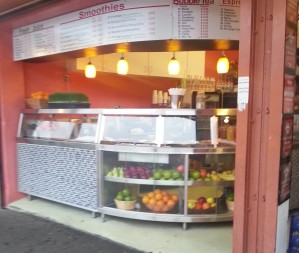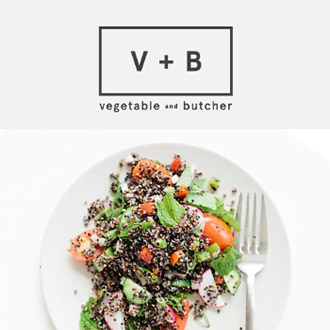I’ve avoided the topic of juice cleanses for a while now. As a lover of whole foods, real cooking, and feeling strong and focused, the diet craze of juicing never appealed to me. At best, people may recover from some minor vitamin and mineral deficiencies over the course of a few days, and at worst, they may throw back sugar by the tablespoon, experience lack of focus, dizziness, and energy and muscle loss over the course of a week, or longer. Write ups like this one in the New York Times make it seem downright miserable: “It was like drinking everything bad that ever happened to me in high school…[t]rying to choke down my second bottle of malignancy the reek so sickened me I had to stop and steady myself on a parked car.”
People love the idea of a way reset their bodies – and lives. Words like “natural” and “cleansing” and “detoxification” and “fasting” make it sound like you’ll be sexier than Gwyneth and more serene than the original Eve by this time next Thursday. Some of these cleansing programs last only a few days, many shoot for a week or two, and extreme ones may go even longer.
A case study:
Though he may not have been inspired by Ms. Paltrow, a friend of mine, JR, recently tried a juice fast for a week. Here is his tale…and a few of my comments. And a recipe, as always, below. Excited to hear your thoughts on this topic, so leave a reply!
___________________________________________________________________________________
WHY WOULD YOU TRY A FAD DIET?
I had a New Year’s resolution to once and for all confront every other resolution I’ve made over the past two years but haven’t accomplished. One of those resolutions was getting my weight in check. My weight has fluctuated over the years, but going into the end of the 2013, I was around 208lbs at 6’2″ and an age of 36 years old. My goal is 190lbs and the closest I have gotten was 198/199lbs about a year ago. The highest I’ve seen in the last 5 years is probably around 218-219lbs.
[Note from Sarah: for an active, young, male like JR, these aren’t “red flag” numbers – they’re actually pretty ideal. Knowing his body fat %, waist circumference, or capacity measures for exercise would give a clearer picture of his health, but suffice it to say that he was, from the start, healthy.]
Sitting at home over the holidays, flipping through the channels, the movie “Fat, Sick and Nearly Dead” was playing. Then, my lightbulb came on. My brilliant idea…. juice for 7 days into the new year while I was off from work. Detox, cleanse, get down to 199lbs jumpstarting my way to 190lbs.
It is probably important to contextualize my diet and lifestyle leading up this decision. I generally eat pretty healthy. No fast foods, not a lot of processed foods. Lots of fiber and protein. I don’t have a sweet tooth. Maybe for a month leading up I had been eating mainly vegetarian (vegetables) for dinner at a controlled portion size. Carbs are really my problem. My company has an on-site food caterer that usually has ethnic foods high in carbs (rice, naan bread, etc). I do high-intensity exercise 4-5 times a week. But, my job has me mostly sedentary all day sitting at a computer.
Living in Seattle, and only a few blocks from Pike’s Market, I had easy access to fresh juicing ingredients. I stuck closely to recipes from Fat, Sick and Nearly Dead. There is also a juice/smoothie stand in the market for times I didn’t want to juice or didn’t have time to juice. I didn’t do any ‘safety’ research’ in advance nor did I seek medical advice/blood testing like they did in the movie. I jumped feet first and only did research after the first couple of days. I’ll summarize what I read…. a) there are clearly health benefits and that was universally called out b) there are also clearly things to be careful about (metabolism changes and blood sugar) and c) I doubt anyone who wrote the articles I read probably ever tried juicing. So, I felt like there was a fair amount of misinformation and many articles are also just trying to sell something like supplements or juicers.
I used this Breville juicer for the drinks I made at home.
JUICING IS NOT FOR THE WEAK OF… ANYTHING
At my size, I wasn’t getting nearly enough calories to sustain – even when I modified the diet with some protein like nuts, or an occasional raw fruit (I tried to avoid this as much as possible). The first couple of days are excruciating as your body goes through craving cycles for whatever it has dependencies on (sweets, carbs, caffeine, etc). This process I classified the first two day withdrawal period as part emotional, part mental, part physical. By the third day, my body shut down around 6-7p and did that consistently for the remaining days. The feeling was similar to the early stages of blacking out — my vision was blurred, I couldn’t see straight and my ears had a low ringing. Generally, my mental focus wasn’t as strong either regardless of time of day. There were times when I was shut down, and juicing perked me up and gave me a bounce in my step. But, that only happened a couple of times and didn’t last long. I exercised probably 5 of the 7 days. Running seemed to be the most successful – but rigorous weight lifting or high-intensity cardio was next to impossible. The earlier in the day I exercised the stronger I felt.
My biggest concern was that I felt like I was losing muscle mass. I felt like my body looked weaker.
[Note from Sarah: It wasn’t just that he felt weaker and like he was losing muscle mass – he likely was! Your muscles and organs are made from fat and protein, which as he notes, were not plentiful during juicing. They’re also crucial for the manufacture of hormones and enzymes.]
THEY’LL KNOW YOU’RE A JUICER
One of the interesting things was how many people asked if I was juicing. Whether at the market, grocery store, etc – people look at what you’re buying and I was asked several times if I was juicing. The ginger is the giveaway apparently. The cost effectiveness of juicing is comparable to your normal food costs. About a day’s worth of ingredients, at Seattle’s most expensive market, cost about $30. I generally drank 24-48 ounces per meal. A good juice at the stand (about 12-16oz) was about $6.

Use the freshest and best ingredients you can find – and nothing from a bag. I used Trader Joe’s shredded Kale in a bag once and it didn’t produce any juice. Normal grocery store vegetable sections are fine. You want the stuff that gets misted while it sits in the refrigerated shelves.
THAT’S A LOT OF WASTE (NOT A LOT OF WAIST)
The thing I struggled with the most was how much food you’re throwing out — literally pounds per juicing of shredded food. I did not research recipes specifically, but on a whim tried mixing the ingredients with corn bread. Seattle has a large homeless population, so I thought baking some healthy breads for them would be a good way to give back to the community. The corn bread wasn’t bad — mixed with Kale and Carrot, but it could have been much better.
Before you start juicing, figure out something positive to do with your waste. Some options are breads, composting or soups.
[Note from Sarah: Amen! Ideally you’ll find a way to EAT the fiber. See recipes below.]
MISSION: NOT ACCOMPLISHED!
I didn’t achieve my goal target in the 7 days as I had wanted. I lost about 4-5 pounds, gained a pound or two back after an NFL-game binge, then lost 3-4 additional pounds over the next week under a modified diet (see below). So, as of two weeks later, I’m around 203 lbs. I had a very noticeable change in my waist size (clothes fit differently) that seemed drastic compared to the relatively small weight loss.
I also noticed some other positive benefits. Over the past year I had developed some sort of allergic reaction to alcohol that led to abdominal pains for multiple days after drinking. I’ve had several tests including CT scans and various nuclear medicine tests with no diagnosis. It appears that after this little juicing detox that I am able to drink alcohol again — and that is really important with the Seahawks in the Superbowl!
[Note from Sarah: That’s a really interesting observation – it could be that his gut microflora populations were changed either in type or amount present, or that the nutrients in juicing somehow altered enzymes he produced? It will be interesting to see if the alcohol tolerance keeps up!]
MY BOTTOM LINE
I probably shouldn’t be giving health advice – but here’s my recommendation. I think I would have felt much better if, instead of juicing for 7 days, I did “two-a-day high intensity” workouts. I think I would have experienced the same weight loss, my body would have looked stronger and my suffering would have been less.
I experienced health benefits from juicing, so I’m a “juicing advocate”. I’ve modified my diet to include a normal high-protein/high-fiber breakfast, a balanced lunch light on carbs and a good fresh vegetable juice for dinner supplemented with peanuts or fruit as needed. I do this 4-5 times a week only. I think this modified diet has been a big reason why I’ve had additional weight loss. I’m strong enough to exercise (burn more calories) and I’m reducing my caloric intake. I expect I’ll reach my target within another week or two.
[Note from Sarah: I think this nails it! Use juicing to get a ton of vitamins and minerals in the context of other nutrients that will support health, and mix in exercise.]
SOME OTHER THINGS TO CONSIDER
- Tastes like dirt water – yes, some times you feel like you’re drinking water with flavored dirt in it. But, some lemons or ginger or both make everything okay.
- Citrus not good – strawberries, bananas, oranges, etc all sound good as a juice (think smoothie). But, for me, the citrus acids were too strong on an empty stomach and the sweetness was overwhelming. Some apples, pears etc in a vegetable filled juice are nice additions, but a “fruit only” juice wasn’t for me.
- Find a stand – juicing doesn’t take a lot of time. But, literally you’ll be going to the grocery store every day or two.

___________________________________________________________________________________
Like my philosophy on all other foods – it all comes down to how much, how often – there can be a place for juicing in your lifestyle. Let’s address the detox perspective: your body can detox itself. If it couldn’t (and in some people, for example those with kidney disease, can’t), you’d die. Your liver, kidney, and spleen are all constantly ridding your body of toxins, unneeded nutrients, and free radicals (some of which are created by completely natural, healthy, metabolic processes). If you support your organs with the right balance of nutrients, you’re detoxing – no starving, colonics, or strange extracts from tropical plants required.
To build juicing into your daily life:
- If you’re going to do a cleanse…don’t go longer than 3 days on juice alone. That’s my personal and professional opinion.
- Use mostly veggies. Fruit juice is very high in sugar, whether it’s freshly squeezed or bottled on the shelf. A little bit of fruit juice goes a long way to improve the flavor – try 4 parts veggie for every fruit you use!
- Pair with a protein, fiber, and fat…a handful of nuts, piece of string cheese, avocado or yogurt based dip, etc
- Eat the pulp…as JR suggests, make it into muffins, scones, crackers, or spreads. There are 10 great ideas on this blog! If you have an excess of food, bring it to the office or give to friends. People will like you more.
- Keep a food journal and include notes about your energy level or observations about digestive issues. This will help you connect the dots between how you feel and what you eat.
Last week, the technique class I taught at Williams Sonoma was all about juicing. We used 3 juicers (one of which was actually a Vitamix; you have to strain it yourself to remove pulp – try using a clean pair of nylon women’s panty hose! or just drink as a smoothie). There are lots of great recipes and guidelines on their juicing page. We made 3 recipes and used carrots, oranges, celery, pears, apples, spinach, parsley, swiss chard, and lemon…the resulting pulp was about 10 cups worth, and looked like this:
I rehydrated some of it with about 2:1 pulp: juice (I know – adding juice seems silly, right? But you need to add some sweetness and get it to a consistency you can spread on a tray.) I greased a pan, spread the mixture about 1/4 – 1/2″ thick, and put in a 200F oven with the door propped open for about 3 /12 hours to dehydrate. The resulting leathers were chewy and sweet enough, though the longer you chew, the more it tastes like silage. Some tasters liked it a lot, others were underwhelmed.
I also baked some into scones; this recipe easily accommodated a cup of pulp. I used a ton of fresh sage (~3 Tbsp), some basil, and upped the whole wheat flour to 50/50. These are fabulous. Next time I’ll try crackers! Any hot tips on what you’ve done with leftover pulp?














Trackbacks/Pingbacks